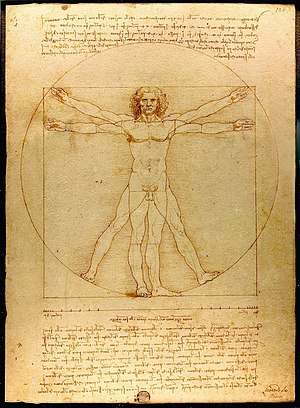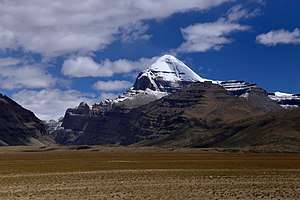Axis mundi
In astronomy, axis mundi is the Latin term for the axis of the Earth between the celestial poles. In a geocentric coordinate system, this is the axis of rotation of the celestial sphere. Consequently, in ancient Greco-Roman astronomy, the axis mundi is the axis of rotation of the planetary spheres of the classical geocentric model of the cosmos.[1]
In 20th-century comparative mythology, the term axis mundi, also called the cosmic axis, world axis, world pillar, center of the world, world tree) was greatly extended to refer to any mythological concept representing "the connection between Heaven and Earth" or the "higher and lower realms".[2] The concept was introduced by Mircea Eliade in the 1950s.[3] It is closely related to the mythological concept of omphalos (navel) of the world or cosmos.[4][5][6] Items adduced as examples of the axis mundi by comparative mythologists include plants (notably a tree but also other types of plants such as a vine or stalk), a mountain, a column of smoke or fire, or a product of human manufacture (such as a staff, a tower, a ladder, a staircase, a maypole, a cross, a steeple, a rope, a totem pole, a pillar, a spire). Its proximity to heaven may carry implications that are chiefly religious (pagoda, temple mount, minaret, church) or secular (obelisk, lighthouse, rocket, skyscraper). The image appears in religious and secular contexts.[7] The axis mundi symbol may be found in cultures utilizing shamanic practices or animist belief systems, in major world religions, and in technologically advanced "urban centers". In Mircea Eliade's opinion, "Every Microcosm, every inhabited region, has a Centre; that is to say, a place that is sacred above all."[8]
Background
The symbol originates in a natural and universal psychological perception: that the spot one occupies stands at "the center of the world". This space serves as a microcosm of order because it is known and settled. Outside the boundaries of the microcosm lie foreign realms that, because they are unfamiliar or not ordered, represent chaos, death or night.[9] From the center one may still venture in any of the four cardinal directions, make discoveries, and establish new centers as new realms become known and settled. The name of China, meaning "Middle Nation" (中国 pinyin: Zhōngguó), is often interpreted as an expression of an ancient perception that the Chinese polity (or group of polities) occupied the center of the world, with other lands lying in various directions relative to it.[7]
Within the central known universe a specific locale-often a mountain or other elevated place, a spot where earth and sky come closest gains status as center of the center, the axis mundi. High mountains are typically regarded as sacred by peoples living near them. Shrines are often erected at the summit or base.[10] Mount Kunlun fills a similar role in China.[11] Mount Kailash is holy to Hinduism and several religions in Tibet. The Pitjantjatjara people in central Australia consider Uluru to be central to both their world and culture. In ancient Mesopotamia the cultures of ancient Sumer and Babylon erected artificial mountains, or ziggurats, on the flat river plain. These supported staircases leading to temples at the top. The Hindu temples in India are often situated on high mountains. E.g. Amarnath, Tirupati, Vaishno Devi etc. The pre-Columbian residents of Teotihuacán in Mexico erected huge pyramids featuring staircases leading to heaven. These Amerindian temples were often placed on top of caves or subterranean springs, which were thought to be openings to the underworld.[12] Jacob's Ladder is an axis mundi image, as is the Temple Mount. For Christians the Cross on Mount Calvary expresses the symbol.[13] The Middle Kingdom, China, had a central mountain, Kunlun, known in Taoist literature as "the mountain at the middle of the world." To "go into the mountains" meant to dedicate oneself to a spiritual life.[14]
Because the axis mundi is an idea that unites a number of concrete images, no contradiction exists in regarding multiple spots as "the center of the world". The symbol can operate in a number of locales at once.[8] Mount Hermon was regarded as the axis mundi in Canaanite tradition, from where the sons of God are introduced descending in 1 Enoch (1En6:6).[15] The ancient Armenians had a number of holy sites, the most important of which was Mount Ararat, which was thought to be the home of the gods as well as the center of the Universe.[16] Likewise, the ancient Greeks regarded several sites as places of earth's omphalos (navel) stone, notably the oracle at Delphi, while still maintaining a belief in a cosmic world tree and in Mount Olympus as the abode of the gods. Judaism has the Temple Mount, Christianity has the Mount of Olives and Calvary, Islam has the Ka'aba, said to be the first building on earth, and the Temple Mount (Dome of the Rock). In Hinduism, Mount Kailash is identified with the mythical Mount Meru and regarded as the home of Shiva; in Vajrayana Buddhism, Mount Kailash is recognized as the most sacred place where all the dragon currents converge and is regarded as the gateway to Shambhala. In Shinto, the Ise Shrine is the omphalos.
Sacred places constitute world centers (omphalos) with the altar or place of prayer as the axis. Altars, incense sticks, candles and torches form the axis by sending a column of smoke, and prayer, toward heaven. The architecture of sacred places often reflects this role. "Every temple or palace—and by extension, every sacred city or royal residence—is a Sacred Mountain, thus becoming a Centre."[17] The stupa of Hinduism, and later Buddhism, reflects Mount Meru. Cathedrals are laid out in the form of a cross, with the vertical bar representing the union of earth and heaven as the horizontal bars represent union of people to one another, with the altar at the intersection. Pagoda structures in Asian temples take the form of a stairway linking earth and heaven. A steeple in a church or a minaret in a mosque also serve as connections of earth and heaven. Structures such as the maypole, derived from the Saxons' Irminsul, and the totem pole among indigenous peoples of the Americas also represent world axes. The calumet, or sacred pipe, represents a column of smoke (the soul) rising form a world center.[18] A mandala creates a world center within the boundaries of its two-dimensional space analogous to that created in three-dimensional space by a shrine.[19]
In the Classical elements and the Vedic Pancha Bhoota the axis mundi corresponds to Aether, the quintessence.

Plants
Plants often serve as images of the axis mundi. The image of the Cosmic Tree provides an axis symbol that unites three planes: sky (branches), earth (trunk) and underworld (roots).[20] In some Pacific island cultures the banyan tree, of which the Bodhi tree is of the Sacred Fig variety, is the abode of ancestor spirits. In Hindu religion, the banyan tree is considered sacred and is called ashwath vriksha ("I am banyan tree among trees" – Bhagavad Gita). It represents eternal life because of its seemingly ever-expanding branches. The Bodhi tree is also the name given to the tree under which Gautama Siddhartha, the historical Buddha, sat on the night he attained enlightenment. The Mesoamerican world tree connects the planes of the Underworld and the sky with that of the terrestrial realm.[21] The Yggdrasil, or World Ash, functions in much the same way in Norse mythology; it is the site where Odin found enlightenment. Other examples include Jievaras in Lithuanian mythology and Thor's Oak in the myths of the pre-Christian Germanic peoples. The Tree of Life and the Tree of Knowledge of Good and Evil in Genesis present two aspects of the same image. Each is said to stand at the center of the Paradise garden from which four rivers flow to nourish the whole world. Each tree confers a boon. Bamboo, the plant from which Asian calligraphy pens are made, represents knowledge and is regularly found on Asian college campuses. The Christmas tree, which can be traced in its origins back to pre-Christian European beliefs, represents an axis mundi.[22]

Human figure
The human body can express the symbol of world axis.[23] Some of the more abstract Tree of Life representations, such as the sefirot in Kabbalism and in the chakra system recognized by Hinduism and Buddhism, merge with the concept of the human body as a pillar between heaven and earth. Disciplines such as yoga and tai chi begin from the premise of the human body as axis mundi. The Buddha represents a world centre in human form.[24] Large statues of a meditating figure unite the human figure with the symbolism of temple and tower. Astrology in all its forms assumes a connection between human health and affairs and the orientation of these with celestial bodies. World religions regard the body itself as a temple and prayer as a column uniting earth to heaven. The ancient Colossus of Rhodes combined the role of human figure with those of portal and skyscraper. The image of a human being suspended on a tree or a cross locates the figure at the axis where heaven and earth meet. The Renaissance image known as the Vitruvian Man represented a symbolic and mathematical exploration of the human form as world axis.[22]
Homes
Homes can represent world centers. The symbolism for their residents is the same as for inhabitants of palaces and other sacred mountains.[17] The hearth participates in the symbolism of the altar and a central garden participates in the symbolism of primordial paradise. In Asian cultures houses were traditionally laid out in the form of a square oriented toward the four compass directions. A traditional Asian home was oriented toward the sky through feng shui, a system of geomancy, just as a palace would be. Traditional Arab houses are also laid out as a square surrounding a central fountain that evokes a primordial garden paradise. Mircea Eliade noted that "the symbolism of the pillar in [European] peasant houses likewise derives from the 'symbolic field' of the axis mundi. In many archaic dwellings the central pillar does in fact serve as a means of communication with the heavens, with the sky."[25] The nomadic peoples of Mongolia and the Americas more often lived in circular structures. The central pole of the tent still operated as an axis but a fixed reference to the four compass points was avoided.[26]

Shamanic function
A common shamanic concept, and a universally told story, is that of the healer traversing the axis mundi to bring back knowledge from the other world. It may be seen in the stories from Odin and the World Ash Tree to the Garden of Eden and Jacob's Ladder to Jack and the Beanstalk and Rapunzel. It is the essence of the journey described in The Divine Comedy by Dante Alighieri. The epic poem relates its hero's descent and ascent through a series of spiral structures that take him from through the core of the earth, from the depths of Hell to celestial Paradise. It is also a central tenet in the Southeastern Ceremonial Complex.[27]
Anyone or anything suspended on the axis between heaven and earth becomes a repository of potential knowledge. A special status accrues to the thing suspended: a serpent, a victim of crucifixion or hanging, a rod, a fruit, mistletoe. Derivations of this idea find form in the Rod of Asclepius, an emblem of the medical profession, and in the caduceus, an emblem of correspondence and commercial professions. The staff in these emblems represents the axis mundi while the serpents act as guardians of, or guides to, knowledge.[28]
Modern expressions
A modern artistic representation of the axis mundi is the Colonne sans fin (The Endless Column, 1938) an abstract sculpture by Romanian Constantin Brâncuși. The column takes the form of a "sky pillar" (columna cerului) upholding the heavens even as its rhythmically repeating segments invite climb and suggest the possibility of ascension.[29]
See also
- Alchemy
- Celestial sphere
- Comparative mythology
- Crucifix
- Fertile Crescent
- Fleur de lis
- Herma
- History of the center of the Universe
- Hyperborea
- North pole
- Optical axis
- Palmette
- Phurba
- Taiji (philosophy)
- Vorticism
References
- the term is used by Geminus in his Elementa, in early modern editions misattributed to Proclus as Commentarius in sphaeram. R.B. Todd, 'The Manuscripts of the Pseudo-Proclan Sphaera', Revue d'histoire des textes 23 (1993), 57-71. The term continues to be used in modern astronomical works throughout the 18th century, e.g. Johann Samuel Traugott Gehler, Physikalisches Wörterbuch (1791), p. 688.
- Mircea Eliade (tr. Philip Mairet). 'Symbolism of the Centre' in Images and Symbols. Princeton, 1991. ISBN 069102068X. p.48-51
- Mircea Eliade (tr. Philip Mairet). 'Symbolism of the Centre' in Images and Symbols. Princeton, 1991. ISBN 069102068X. p.40
- J. C. Cooper. An Illustrated Encyclopedia of Traditional Symbols. Thames and Hudson: New York, 1978. ISBN 0500271259.
- Mircea Eliade (tr. Willard Trask). 'Archetypes and Repetition' in The Myth of the Eternal Return. Princeton, 1971. ISBN 0691017778. p.16
- Winther, Rasmus Grønfeldt (2014) World Navels. Cartouche 89: 15–21 https://www.academia.edu/8727362/World_Navels
- Jean Chevalier and Alain Gheerbrandt. A Dictionary of Symbols. Penguin Books: London, 1996. ISBN 0140512543. pp.61–63, 173–175
- Mircea Eliade (tr. Philip Mairet). 'Symbolism of the Centre' in Images and Symbols. Princeton, 1991. ISBN 069102068X. p.39
- Mircea Eliade (tr. Philip Mairet). 'Symbolism of the Centre' in Images and Symbols. Princeton, 1991. ISBN 069102068X. p.37-39
- Mircea Eliade (tr. Philip Mairet). 'Symbolism of the Centre' in Images and Symbols. Princeton, 1991. ISBN 069102068X. p.41-43
- Wang, Chong. Lunheng Part I: Philosophical Essays of Wang Ch'ung. Trans. Alfred Forke. London: Luzac & Co., 1907. p.337.
- Bailey, Gauvin Alexander (2005). Art of Colonial Latin America. New York (NY): Phaidon Press Limited. pp. 21.
- Jean Chevalier and Alain Gheerbrandt. A Dictionary of Symbols. Penguin Books: London, 1996. ISBN 0140512543. pp.680–685
- Jean Chevalier and Alain Gheerbrandt. A Dictionary of Symbols. Penguin Books: London, 1996. ISBN 0140512543. pp.681
- Bautch, Kelley Coblentz (25 September 2003). A Study of the Geography of 1 Enoch 17–19: "no One Has Seen what I Have Seen". BRILL. p. 62. ISBN 978-90-04-13103-3.
- "Noah´s ark in the Mountains of Armenia". 11 August 2013.
- Mircea Eliade (tr. Willard Trask). 'Archetypes and Repetition' in The Myth of the Eternal Return. Princeton, 1971. ISBN 0691017778. p.12
- Jean Chevalier and Alain Gheerbrandt. A Dictionary of Symbols. Penguin Books: London, 1996. ISBN 0140512543. pp.148–149
- Mircea Eliade (tr. Philip Mairet). 'Symbolism of the Centre' in Images and Symbols. Princeton, 1991. ISBN 069102068X. p.52-54
- Mircea Eliade (tr. Philip Mairet). 'Symbolism of the Centre' in Images and Symbols. Princeton, 1991. ISBN 069102068X. p.42-45
- Miller, Mary; Karl Taube (1993). The Gods and Symbols of Ancient Mexico and the Maya. London: Thames and Hudson. p. 186. ISBN 0500050686.
- Chevalier, Jean and Gheerbrandt, Alain. A Dictionary of Symbols. Penguin Books: London, 1996. ISBN 0140512543. pp.1025–1033
- Mircea Eliade (tr. Philip Mairet). 'Symbolism of the Centre' in Images and Symbols. Princeton, 1991. ISBN 069102068X. p.54
- Mircea Eliade (tr. Philip Mairet). 'Indian Symbolisms of Time and Eternity' in Images and Symbols. Princeton, 1991. ISBN 069102068X. p.76
- Mircea Eliade. 'Brâncuși and Mythology' in Symbolism, the Sacred, and the Arts. Continuum, 1992. ISBN 0826406181. p. 100
- Jean Chevalier and Alain Gheerbrandt. A Dictionary of Symbols. Penguin Books: London, 1996. ISBN 0140512543. pp.529–531
- Townsend, Richard F. (2004). Hero, Hawk, and Open Hand. Yale University Press. ISBN 0-300-10601-7.
- Jean Chevalier and Alain Gheerbrandt. A Dictionary of Symbols. Penguin Books: London, 1996. ISBN 0140512543. pp.142–145
- Mircea Eliade. 'Brâncuși and Mythology' in Symbolism, the Sacred, and the Arts. Continuum, 1992. ISBN 0826406181. p.99-100
